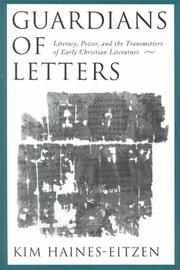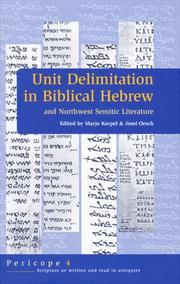| Listing 1 - 5 of 5 |
Sort by
|
Book
ISBN: 9780195171297 0195171292 0199918147 0199910030 Year: 2012 Publisher: New York Oxford University Press
Abstract | Keywords | Export | Availability | Bookmark
 Loading...
Loading...Choose an application
- Reference Manager
- EndNote
- RefWorks (Direct export to RefWorks)
The book provides a thorough treatment of the roles of women as authors, scribes, booklenders, and patrons of early Christian literature, and of the ways in which the representation of female figures was contested in the process of copying early Christian texts.
Christian literature, Early --- Women and literature. --- Women in literature. --- History and criticism. --- 396.7 --- Woman (Christian theology) in literature --- Women in drama --- Women in poetry --- Literature --- Vrouw en religie --- 396.7 Vrouw en religie --- Women and literature --- Women in literature --- History and criticism --- Littérature chrétienne primitive --- Femmes et littérature --- Femmes --- Histoire et critique --- Dans la littérature

ISBN: 0195135644 0195350545 1280473401 142376059X 9781423760597 9781280473401 9780195135640 0197739458 Year: 2023 Publisher: New York ; Oxford University Press,
Abstract | Keywords | Export | Availability | Bookmark
 Loading...
Loading...Choose an application
- Reference Manager
- EndNote
- RefWorks (Direct export to RefWorks)
This book looks at the question of how early Christian literature came to us in its present form. Drawing on literary and archaeological evidence, the author argues that the scribes who copied this early literature were also the users of it.
Christian literature, Early --- Latin literature --- Scribes --- Transmission of texts --- History and criticism. --- Christian authors --- 091:2 --- -Scribes --- -Christian literature, Early --- -Early Christian literature --- Patristic literature --- Copyists --- Literary transmission --- Manuscript transmission --- Textual transmission --- Criticism, Textual --- Editions --- Manuscripts --- 091:2 Handschriftenkunde. Handschriftencatalogi-:-Godsdienst. Theologie --- Handschriftenkunde. Handschriftencatalogi-:-Godsdienst. Theologie --- Latin authors --- -History and criticism --- Scribes, Roman --- Roman literature --- Classical literature --- Classical philology --- Latin philology --- History and criticism --- Christian authors&delete& --- Early Christian literature
Book
ISBN: 9780691232898 069123289X 9780691237411 Year: 2022 Publisher: Princeton Princeton University Press
Abstract | Keywords | Export | Availability | Bookmark
 Loading...
Loading...Choose an application
- Reference Manager
- EndNote
- RefWorks (Direct export to RefWorks)
"Deserts have a long religious history. Think of the biblical stories of the ancient Israelites migrating through deserts after they had been freed from slavery in Egypt, and the stories from the New Testament of Jesus being tempted in the desert. Early Christian monks and hermits were deeply influenced by such stories, drawing from them the lesson that the desert is an important place. It's the place to which one flees the cacophony and distractions of the marketplace and town square in order to hear and contemplate the voice of God in solitude. (Of course, the practice of withdrawal was a Graeco-Roman ideal as well as a biblical one, and some early monks were surely influenced by pre-Christian philosophical ideas about the power of solitude too.) Alone or in monastic communities -- which, paradoxically, blended the communal and the solitary -- monks found something surprising in the harsh desert environment: while they went there in search of silence, they found that the desert, too, is rich with sound -- which one can appreciate if one pays attention. One has to learn to listen to the subtle, natural sounds of the desert in order to become quiet and still enough to "listen with the ear of the heart," in the words of the sixth-century AD monk Benedict of Nursia. Kim Haines Eitzen has written a book about the sayings, anecdotes, and stories of these desert monks, based on her reading of a wide range of texts written in Greek, Coptic, and Latin between the third and seventh centuries, including letters, treatises, and philosophical and practical instructions for monastic life. This material speaks to the interdependence between humans and other animals, and between humans and the environment. The author highlights the ways in which monks wrestled with the sounds of the desert and how they used these to cultivate a quality of inner listening. She invites her readers to reflect with her on what we might learn about our own world from their experience and stories -- how, in the midst of our cacophonous surroundings, we might cultivate a sense of inner quietude. And how we might grapple with the tensions that those early monks also felt, between the pulls of solitude and community. Accompanying this book are a set of audio recordings the author made in desert environments"-- "Enduring lessons from the desert soundscapes that shaped the Christian monastic traditionFor the hermits and communal monks of antiquity, the desert was a place to flee the cacophony of ordinary life in order to hear and contemplate the voice of God. But these monks discovered something surprising in their harsh desert surroundings: far from empty and silent, the desert is richly reverberant. Sonorous Desert shares the stories and sayings of these ancient spiritual seekers, tracing how the ambient sounds of wind, thunder, water, and animals shaped the emergence and development of early Christian monasticism.Kim Haines-Eitzen draws on ancient monastic texts from Egypt, Sinai, and Palestine to explore how noise offered desert monks an opportunity to cultivate inner quietude, and shows how the desert quests of ancient monastics offer profound lessons for us about what it means to search for silence. Drawing on her own experiences making field recordings in the deserts of North America and Israel, she reveals how mountains, canyons, caves, rocky escarpments, and lush oases are deeply resonant places. Haines-Eitzen discusses how the desert is place of paradoxes, both silent and noisy, pulling us toward contemplative isolation yet giving rise to vibrant collectives of fellow seekers.Accompanied by Haines-Eitzen's evocative audio recordings of desert environments, Sonorous Desert reveals how desert sounds taught ancient monks about solitude, silence, and the life of community, and how they can help us understand ourselves if we slow down and listen"--
Listening --- Monastic and religious life --- Deserts --- Silence --- Solitude --- 276:248 --- 276:271 --- 248.122 --- 248.153.6 --- 248.153.6 Stilzwijgen als geestelijke oefening --- Stilzwijgen als geestelijke oefening --- 248.122 Ascetische praktijken in het kloosterleven --- Ascetische praktijken in het kloosterleven --- 276:271 Patrologie. Patristiek-:-Kloosterwezen. Religieuze orden en congregaties. Monachisme --- 276:271 Patrologie. Patristique-:-Ordres religieux. Congregations religieuses. Monachisme --- Patrologie. Patristiek-:-Kloosterwezen. Religieuze orden en congregaties. Monachisme --- Patrologie. Patristique-:-Ordres religieux. Congregations religieuses. Monachisme --- 276:248 Patrologie. Patristiek-:-Spiritualiteit. Ascese. Mystiek. Vroomheid --- 276:248 Patrologie. Patristique-:-Spiritualite. Ascese. Mystique. Theologie ascetique et mystique. Devotion --- Patrologie. Patristiek-:-Spiritualiteit. Ascese. Mystiek. Vroomheid --- Patrologie. Patristique-:-Spiritualite. Ascese. Mystique. Theologie ascetique et mystique. Devotion --- Religious aspects --- Christianity --- History
Book
Year: 2012 Publisher: Oxford Oxford University Press
Abstract | Keywords | Export | Availability | Bookmark
 Loading...
Loading...Choose an application
- Reference Manager
- EndNote
- RefWorks (Direct export to RefWorks)
Religious studies --- Christian religion --- Sociology of culture --- Sociology of the family. Sociology of sexuality --- Thematology --- Discourse analysis --- Religious texts --- Reading habits --- Religion --- Writers --- Images of women --- Book --- Christianity

ISSN: 15683443 ISBN: 9023239784 9004494413 Volume: 4 Publisher: Assen Koninklijke Van Gorcum
Abstract | Keywords | Export | Availability | Bookmark
 Loading...
Loading...Choose an application
- Reference Manager
- EndNote
- RefWorks (Direct export to RefWorks)
Bible scholars and translators are often confronted with the problem of sectioning biblical texts. Until recently sentence division and paragraphing were largely left to the imagination of the individual scholar. This resulted in a wide range of different divisions of one and the same text. There is, however, a lot of long neglected evidence on how the ancient scribes themselves understood the structure of the texts they were transmitting. Research in ancient scribal traditions shows that in the entire ancient Near East scribes provided their texts with special, structuring markers. For example, rulings, lines left open, extra large capitals, different colouring at the beginning of new passages, and for the division into smaller units, strokes, dots and spaces. Actually many markers lending structure to our modern texts appear to be derived from very ancient customs. This volume contains the papers read during the Third Pericope Meeting held in connection with the SBL International Meeting at Berlin, 2002. Topics discussed are the unit delimitation in parts of Genesis, Numbers, Isaiah, Ezekiel, Psalms, and Song of Songs. Furthermore general studies on Masoretic accentuation, the importance of pausal forms for unit delimitation, description of scribal practices in the Jewish tradition, as well as unit division in Northwest Semitic texts are included.
Semitic literature --- 221.02*1 --- 221.02*1 Oud Testament: bijbelse filologie: hebreeuws --- Oud Testament: bijbelse filologie: hebreeuws --- Middle Eastern literature --- Criticism, Textual --- Bible. --- Antico Testamento --- Hebrew Bible --- Hebrew Scriptures --- Kitve-ḳodesh --- Miḳra --- Old Testament --- Palaia Diathēkē --- Pentateuch, Prophets, and Hagiographa --- Sean-Tiomna --- Stary Testament --- Tanakh --- Tawrāt --- Torah, Neviʼim, Ketuvim --- Torah, Neviʼim u-Khetuvim --- Velho Testamento --- Paragraphs --- Conferences - Meetings
| Listing 1 - 5 of 5 |
Sort by
|

 Search
Search Feedback
Feedback About
About Help
Help News
News